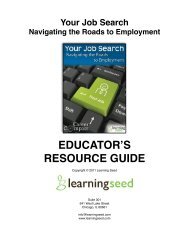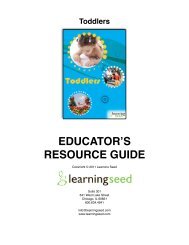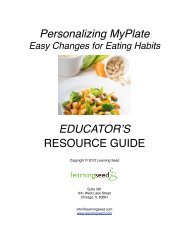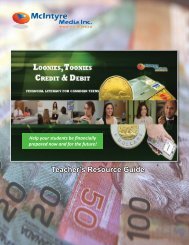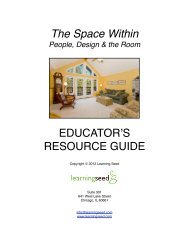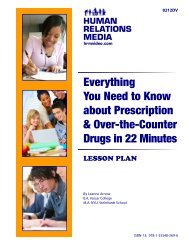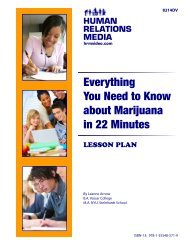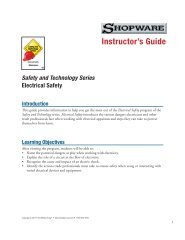Guiding Behavior In Young Children - Amazon Web Services
Guiding Behavior In Young Children - Amazon Web Services
Guiding Behavior In Young Children - Amazon Web Services
You also want an ePaper? Increase the reach of your titles
YUMPU automatically turns print PDFs into web optimized ePapers that Google loves.
<strong>Guiding</strong> <strong>Behavior</strong> <strong>In</strong> <strong>Young</strong> <strong>Children</strong>:<br />
Expert Approaches for Caregivers & Parents<br />
EDUCATORʼS<br />
RESOURCE GUIDE<br />
Copyright © 2011 Learning Seed<br />
Suite 301<br />
641 West Lake Street<br />
Chicago, IL 60661<br />
info@learningseed.com<br />
www.learningseed.com
Legal Niceties<br />
This Resource Guide<br />
Copyright © 2010 Learning Seed.<br />
This educatorʼs resource guide is copyrighted according to the terms of the Creative Commons non-commercial<br />
license (http://creativecommons.org/licenses/by-nc/2.5/). It may be reproduced, in its part or its entirety, for classroom<br />
use. No part of this guide may be reproduced for sale by any party.<br />
You are free:<br />
· to copy, distribute, display, and perform the work.<br />
· to make derivative works.<br />
Under the following conditions:<br />
· Attribution. You must attribute the work to Learning Seed.<br />
· Noncommercial. You may not use this work for commercial purposes.<br />
· For any reuse or distribution, you must make clear to others the license terms of this work.<br />
· Any of these conditions can be waived if you get permission from the copyright holder.<br />
Resource Guide Credits<br />
Writer: Kathleen O. Ryan<br />
Editor: Kari McCarthy<br />
Copy Editor: Mike Robbins<br />
The Video: <strong>Guiding</strong> <strong>Behavior</strong> in <strong>Young</strong> <strong>Children</strong>: Expert Approaches for Caregivers & Parents<br />
Copyright © 2010 Learning Seed.<br />
This video program is protected under U.S. copyright law. No part of this video may be reproduced or transmitted<br />
by any means, electronic or mechanical, without the written permission of the Publisher, except where permitted by<br />
law.<br />
DVD LS-1349-11-DVD! ISBN 1-55740-587-5<br />
Closed Captioning<br />
This program is closed-captioned.<br />
Questions, suggestions or comments?<br />
Email us at info@learningseed.com or call us at: 800.634.4941<br />
<strong>Guiding</strong> <strong>Behavior</strong> in <strong>Young</strong> <strong>Children</strong>: Expert Approaches for Caregivers & Parents<br />
2 Copyright 2011 Learning Seed
Table of Contents<br />
Program Summary..............................................................................................................................................4<br />
National Standards.............................................................................................................................................5<br />
Additional Resources.........................................................................................................................................6<br />
Lesson Plans<br />
! Guide and Create Expectation:<br />
! Lesson 1a: “Kids Will Be Kids” (<strong>In</strong>dependent Practice)..........................................................................7-8<br />
! OR<br />
! Lesson 1b: Unit Pre-test (Fill-in-the-blank)................................................................................................9<br />
! Define and <strong>In</strong>terpret <strong>In</strong>formation:<br />
! Students watch the video <strong>Guiding</strong> <strong>Behavior</strong> in <strong>Young</strong> <strong>Children</strong>: Expert Approaches for Caregivers &<br />
! Parents during this lesson.<br />
! Lesson 2: “Good Advice” (<strong>In</strong>dependent Practice)...............................................................................10-11<br />
! AND<br />
! Lesson 3: “Child Abuse Awareness” (Poster).....................................................................................12-13<br />
! Generate and Differentiate Ideas:<br />
! Lesson 4: “Act It Out” (Skit)................................................................................................................14-15<br />
! Develop and Evaluate Performance:<br />
! Lesson 5a: “Creating a Plan” (Action Plan)........................................................................................16-17<br />
! OR<br />
! Lesson 5b: Unit Post-test (Fill-in-the-blank)............................................................................................18<br />
Appendix.................................................................................................................................................19<br />
! Student Worksheets<br />
! Rubrics<br />
! Student Glossary<br />
<strong>Guiding</strong> <strong>Behavior</strong> in <strong>Young</strong> <strong>Children</strong>: Expert Approaches for Caregivers & Parents<br />
3 Copyright 2011 Learning Seed
Program Summary<br />
Despite their best moments, toddlers and preschoolers often behave in ways that frustrate their parents and caregivers,<br />
and even endanger their own safety. They are not intentionally being "bad." Parents and caregivers can guide them in a<br />
positive way. <strong>In</strong> this program we learn why misbehavior occurs, common reactions by caregivers, ways to stop it, and how<br />
to create and enforce a plan to bring about desired behavior.<br />
Unit Teaching Points<br />
1. Some common behavior difficulties for this age group include: tantrums, sleep and eating problems, aggressive<br />
behaviors, resistance, defiance, and teasing.<br />
2. All children have core emotional needs: attention, affection, affirmation, and acceptance; and may show signs of<br />
misbehavior if these are not met by parents and caregivers.<br />
3. Some reasons for misbehavior are: curiosity, need for attention, immaturity, the desire for independence, and over or<br />
under-stimulation.<br />
4. Physical factors like tiredness, hunger or illness can contribute to misbehavior.<br />
5. Hitting, belittling, threatening behaviors directed at children are always wrong, and if they happen, adults need to<br />
immediately apologize to the child and make sure they never happen again.<br />
6. While using time outs is a common practice for parents, caregivers and teachers, there are better methods that are<br />
more effective and developmentally appropriate for young children.<br />
7. Some rules of thumb to help with the misbehavior of young children include: Pick your battles. Keep it simple. Be<br />
patient. Be consistent. Follow through. Have a plan.<br />
8. The components of a good plan for guiding behavior are: goals, expectations, consequences, and rewards.<br />
9. There are two kinds of goals for improving behavior: guiding a child to stop a behavior and guiding a child to perform<br />
a behavior.<br />
10. A successful plan to guide behavior includes: observation, documentation, and reflection followed by identification of<br />
the behavior in need of change. Parents and caregivers will determine the smallest amount of change toward<br />
reaching a goal as well as inform the child of rewards and consequences connected to their behavior.<br />
Related Learning Seed Programs<br />
Disciplining Kids<br />
Rules, Rituals, Routines<br />
A Childʼs Mind: How Kids Learn Right & Wrong<br />
<strong>Guiding</strong> <strong>Behavior</strong> in <strong>Young</strong> <strong>Children</strong>: Expert Approaches for Caregivers & Parents<br />
4 Copyright 2011 Learning Seed
National Standards<br />
NASAFACS - National Standards for Family and Consumer Sciences as they apply to Child development<br />
4.0 Education and Early Childhood<br />
! 4.2 Analyze developmentally appropriate practices to plan for early childhood, education, and services.<br />
" 4.3 Demonstrate integration of curriculum and instruction to meet children's developmental needs and interests<br />
! 4.4 Demonstrate a safe and healthy learning environment for children.<br />
! 4.5 Demonstrate techniques for positive collaborative relationships with children.<br />
! 4.6 Demonstrate professional practices and standards related to working with children.!<br />
12.0 Human Development<br />
" 12.1 Analyze principles of human growth and development across the life span<br />
! 12.2 Analyze conditions that influence human growth and development.<br />
! 12.3 Analyze strategies that promote growth and development across the life span.<br />
15.0 Parenting<br />
" 15.1 Analyze roles and responsibilities of parenting.<br />
<strong>Guiding</strong> <strong>Behavior</strong> in <strong>Young</strong> <strong>Children</strong>: Expert Approaches for Caregivers & Parents<br />
! 15.2 Evaluate parenting practices that maximize human growth and development.<br />
5 Copyright 2011 Learning Seed
Additional Resources<br />
For research and additional content:<br />
Kid Source<br />
www.kidsource.com/kidsource/content/positive.discipline.html<br />
National Network for Childcare<br />
www.nncc.org/Guidance/guide.dev.apprch.html<br />
Zero To Three<br />
www.zerotothree.org/child-development<br />
<strong>Behavior</strong> Guidance For <strong>In</strong>fants and Toddlers From Birth to 3 Years<br />
Alice S. Honig<br />
<strong>Guiding</strong> <strong>Young</strong> <strong>Children</strong>ʼs <strong>Behavior</strong>:Helpful Ideas for Parents & Teachers From 28 Early Childhood Experts<br />
Betty Farber<br />
Emotional Life of the Toddler<br />
Alicia F. Lieverman<br />
Positive Discipline for Preschoolers<br />
Jane Nelson<br />
<strong>Guiding</strong> <strong>Behavior</strong> in <strong>Young</strong> <strong>Children</strong>: Expert Approaches for Caregivers & Parents<br />
6 Copyright 2011 Learning Seed
Lesson Plan 1a (page 1 of 2)<br />
Purpose: " Guide and Create Expectations<br />
Name: " “Kids Will Be Kids”<br />
Type: " <strong>In</strong>dependent Practice<br />
Est. time: " 40 minutes<br />
Lesson Summary<br />
Students will brainstorm examples of toddler and preschooler misbehavior that they have witnessed and then<br />
discover what typical behavior is for that age group in the physical, intellectual, social and emotional aspects<br />
of development.<br />
Lesson Materials<br />
• Copies of “Kids Will Be Kids” (Worksheet A) for each student<br />
• Pen/Pencil<br />
• Computer with online access (www.childdevelopmentinfo.com/development/devsequence.shtml)<br />
Lesson Objectives<br />
<strong>Guiding</strong> <strong>Behavior</strong> in <strong>Young</strong> <strong>Children</strong>: Expert Approaches for Caregivers & Parents<br />
:<br />
• The student will describe examples of misbehavior they have witnessed from toddlers and preschoolers.<br />
• The student will identify the typical characteristics of young children at ages 2 through 5 years of age..<br />
• The student will Identify behaviors as being influenced by physical, intellectual, social, or emotional development.<br />
• The student will match behaviors to the typical characteristics that influence them.<br />
• The student will analyze why developmental characteristics influence behavior.<br />
! The lesson objectives of Lesson 1a correlate to Unit Teaching Points 1, 3, and 4. See page 4 for a list of unit<br />
! teaching points.<br />
7 Copyright 2011 Learning Seed
Lesson Plan 1a (page 2 of 2)<br />
(Estimated Time: 40 minutes)<br />
I. Lesson Set-up (5 minutes)<br />
PRE-READING<br />
1. <strong>In</strong>struct students to brainstorm specific examples of ways they have seen toddlers and preschoolers<br />
misbehave.(2-5 year-olds)<br />
2. Write a comprehensive list of their responses on an overhead or white board that they can refer back to<br />
during the lesson.<br />
3. Distribute copies of Worksheet A “Kids Will Be Kids” from the Appendix and read it over with the students.<br />
II. Learning Activity (30 minutes)<br />
DURING READING (10 minutes)<br />
<strong>In</strong>struct students to read the following webpage while keeping in mind the directives on Worksheet A:<br />
POST-READING (20 minutes)<br />
www.childdevelopmentinfo.com/development/devsequence.shtml)<br />
<strong>In</strong>struct students to:<br />
1. Fill out Worksheet A<br />
2. Have a class discussion in which students can share some of their worksheet responses.<br />
III. Closure: Discussion (5 minutes)"<br />
Each day, ask these five questions to guide a closing discussion about <strong>Guiding</strong> <strong>Behavior</strong> in young children.<br />
• What are some common behavior problems of toddlers and preschoolers?<br />
• What are the core emotional needs of toddlers and preschoolers?<br />
• What are some common reasons why toddlers and preschoolers may misbehave?<br />
• What are some examples of parent and caregiver misbehavior that can occur while guiding the behavior of<br />
toddlers and preschoolers?<br />
<strong>Guiding</strong> <strong>Behavior</strong> in <strong>Young</strong> <strong>Children</strong>: Expert Approaches for Caregivers & Parents<br />
• What are the components of a plan to positively guide a young childʼs behavior?<br />
8 Copyright 2011 Learning Seed
Lesson Plan 1b (Alternative)<br />
Purpose: " Guide & Create Expectations<br />
Name: " Unit Pre-test<br />
Type: " Fill-in-the-blank<br />
Est. Time: " 30 minutes<br />
<strong>Guiding</strong> <strong>Behavior</strong> Unit Pre-test<br />
As an alternative to Lesson 1a: “Kids Will Be Kids,” you can create and guide student expectations with the<br />
Fill in the blank pre-test found on Worksheet B of the Appendix. The Answer Key is below.<br />
Unit Pre-test Answer Key<br />
All children have core emotional needs: 1. attention , 2. affection , 3. affirmation , and 4. acceptance .<br />
Fulfillment of these needs is a necessary foundation for children to reach their full 5. potential . We can help encourage<br />
6. curiosity if we provide lots of safe places and objects to explore as well as allow for some 7. supervised<br />
explorations. Expectations of certain behaviors may be unrealistic because a child may not be 8. cognitively or<br />
9. socially able to comply. <strong>Children</strong> want grown ups to call the shots and define 10. limits for them which help them<br />
feel 11. safe . <strong>Children</strong> often misbehave if they are over or under 12. stimulated , or they may simply be 13. tired ,<br />
14. hungry , or 15. ill .<br />
Some rules of thumb to positively guide behavior are: pick your 16. battles , keep it 17. simple , and be 18. patient<br />
and 19. consistent . It is also important to 20. follow through with what you say you are going to do and to have a<br />
21. plan already in place for improving behavior. First set a 22. goal , a desired behavior the child will try to start or<br />
stop. Then decide on your 23. expectation , the smallest sign of change you will look for. Decide on<br />
24. consequences if the child doesnʼt comply. The best 25. reward a child can get is the good feeling from doing, or<br />
not doing, a behavior that they are working on.<br />
<strong>Guiding</strong> <strong>Behavior</strong> in <strong>Young</strong> <strong>Children</strong>: Expert Approaches for Caregivers & Parents<br />
9 Copyright 2011 Learning Seed
Lesson Plan 2 . (page 1 of 2)<br />
Purpose: " Define and <strong>In</strong>terpret <strong>In</strong>formation<br />
Name: " “Good Advice”<br />
Type: " <strong>In</strong>dependent Practice<br />
Est. time: " 40 minutes<br />
Lesson Summary<br />
Students will watch the video <strong>Guiding</strong> <strong>Behavior</strong> in <strong>Young</strong> <strong>Children</strong>: Expert Approaches for Caregivers &<br />
Parents while making notes on the practical advice given throughout the program.<br />
Lesson Materials<br />
• Copies of “Good Advice” (Worksheet C) for each student<br />
• Pen/pencil/Journal<br />
• Video: <strong>Guiding</strong> <strong>Behavior</strong> in <strong>Young</strong> <strong>Children</strong>: Expert Approaches for Caregivers & Parents<br />
Lesson Objectives<br />
<strong>Guiding</strong> <strong>Behavior</strong> in <strong>Young</strong> <strong>Children</strong>: Expert Approaches for Caregivers & Parents<br />
• The student will identify the emotional needs of young children.<br />
• The student will match behavior guidance advice to corresponding emotional needs.<br />
• The student will identify common reasons for misbehavior in early childhood.<br />
• The student will match behavior guidance advice to corresponding reasons for misbehavior.<br />
• The student will identify rules of thumb to help positively guide the behavior of young children.<br />
• The student will match behavior guidance advice to corresponding rules of thumb.<br />
! The lesson objectives of Lesson 2 correlate to Unit Teaching Points 2, 3, 4,and 7. See page 4 for a list of unit<br />
! teaching points.<br />
10 Copyright 2011 Learning Seed
Lesson Plan 2 (page 2 of 2)<br />
(Estimated Time: 40 minutes)<br />
I. Lesson Set-up (5 minutes)<br />
BEFORE the video:<br />
1. <strong>In</strong>struct students to complete this sentence in their journal: If i find myself responsible for guiding the behavior<br />
of a young child and need advice, I will ask _____________________ because he/she<br />
___________________________<br />
2. Place responses up on an overhead or whiteboard and have a brief discussion about who they trust to give<br />
good advice on this topic and why.<br />
3. Distribute Worksheet C from Appendix and read through it with the class.<br />
II. Learning Activity (30 minutes)<br />
DURING the video:<br />
1. Remind students to look for advice in the video that matches the topics on their worksheets<br />
2. Students should watch the video as they fill in worksheet C from Appendix.<br />
AFTER the video:<br />
1. Collect worksheets to grade, or have a class discussion about their answers.<br />
III. Closure: Discussion (5 minutes)"<br />
Each day, ask these five questions to guide a closing class discussion about <strong>Guiding</strong> <strong>Behavior</strong> in young children.<br />
• What are some common behavior problems of toddlers and preschoolers?<br />
• What are the core emotional needs of toddlers and preschoolers?<br />
• What are some common reasons why toddlers and preschoolers may misbehave?<br />
• What are some examples of parent and caregiver misbehavior while guiding the behavior of toddlers and<br />
preschoolers?<br />
<strong>Guiding</strong> <strong>Behavior</strong> in <strong>Young</strong> <strong>Children</strong>: Expert Approaches for Caregivers & Parents<br />
• What are the components of a plan to positively and successfully guide a young childʼs behavior?<br />
11 Copyright 2011 Learning Seed
Lesson Plan 3 (page 1 of 2)<br />
Purpose: " Define & <strong>In</strong>terpret <strong>In</strong>formation<br />
Name: " “Child Abuse Prevention”<br />
Type: " Poster<br />
Est. Length: " 40 minutes, (2 class periods)<br />
Lesson Summary<br />
Students will research the topic of child abuse and then create a poster that raises awareness about abuse<br />
prevention and present the poster during the next class period.<br />
Lesson Materials<br />
• Copies of “Child Abuse Prevention Poster” Rubric (Worksheet G) for each student<br />
• Poster board<br />
• Pens, pencils, markers, paints, crayons etc.<br />
• Computer with internet access :<br />
www.helpguide.org/mental/child_abuse_physical_emotional_sexual_neglect.htm<br />
Lesson Objectives<br />
<strong>Guiding</strong> <strong>Behavior</strong> in <strong>Young</strong> <strong>Children</strong>: Expert Approaches for Caregivers & Parents<br />
• The student will identify what child abuse is and what causes it.<br />
• The student will conclude the best way to visually represent a call to prevent child abuse.<br />
:<br />
• The student will create a poster that will raise awareness about how child abuse can be prevented.<br />
! The lesson objectives of Lesson 3 correlate to Unit Teaching Points 2 and 5. See page 4 for a list of unit teaching<br />
! points<br />
12 Copyright 2011 Learning Seed
Lesson Plan 3 (page 2 of 2)<br />
(Estimated Time: 45 minutes)<br />
I. Lesson Set-up (5 minutes)<br />
Journal & Discussion Activity<br />
1. <strong>In</strong>struct students to write in their journal about what they think they should do if they know of or suspect a young<br />
child is being abused.<br />
2. Discuss journal responses as a class.<br />
II. Learning Activity (35 minutes)<br />
“Abuse Prevention Poster” <strong>In</strong>dependent Activity<br />
1. Distribute Abuse Prevention Poster Rubric from the Appendix and discuss with the class.<br />
2. <strong>In</strong>struct each student to visit the website:<br />
http://helpguide.org/mental/child_abuse_physical_emotional_sexual_neglect.htm<br />
3. <strong>In</strong>struct the class to create a poster that advocates the prevention of child abuse using facts, ideas and resources<br />
found on the Help Guide webpage. Remind them to compare their poster to the rubric.<br />
4. Students should be prepared to present their poster during the next class period.<br />
III. Closure: Discussion (5 minutes)<br />
Each day, ask these five questions to guide a closing discussion about <strong>Guiding</strong> <strong>Behavior</strong> in young children.<br />
• What are some common behavior problems of toddlers and preschoolers?<br />
• What are the core emotional needs of toddlers and preschoolers?<br />
• What are some common reasons why toddlers and preschoolers may misbehave?<br />
• What are some examples of parent and caregiver misbehavior while guiding the behavior of toddlers<br />
and preschoolers?<br />
<strong>Guiding</strong> <strong>Behavior</strong> in <strong>Young</strong> <strong>Children</strong>: Expert Approaches for Caregivers & Parents<br />
• What are the components of a plan to positively and successfully guide a young childʼs behavior?<br />
13 Copyright 2011 Learning Seed
Lesson Plan 4 (page 1 of 2)<br />
Purpose: " Generate and Differentiate Ideas<br />
Name: " “Act It Out”<br />
Type: " Skit<br />
Est. time: " 45 minutes (2 class periods)<br />
Lesson Summary<br />
Pairs of students will create and perform skits that illustrate how to execute a plan to get a young child to start<br />
or stop a behavior.<br />
Lesson Materials<br />
• Copies of “Act It Out” (Worksheet D) for each student.<br />
• Copies of Skit Rubric (Worksheet H) for each student<br />
• Pen/paper/journal<br />
Lesson Objectives<br />
<strong>Guiding</strong> <strong>Behavior</strong> in <strong>Young</strong> <strong>Children</strong>: Expert Approaches for Caregivers & Parents<br />
• The student will recall rules of thumb for dealing with misbehavior in early childhood .<br />
• The student will create a scenario that can be acted out to illustrate how to guide the starting or stopping of a<br />
behavior.<br />
• The student will compose a skit which dramatizes positive behavior guidance of a young child.<br />
• The student will perform a skit with a partner for the class.<br />
! The lesson objectives of Lesson 4 correlate to Unit Teaching Points 8 and 9 See page 4 for a list of unit<br />
! teaching points.<br />
14 Copyright 2011 Learning Seed
Lesson Plan 4 (page 2 of 2)<br />
(Estimated Time: 45 minutes; 2 class periods)<br />
I. Lesson Set-up (5 minutes)<br />
Journal & Discussion Activity<br />
1. Distribute copies of “Act It Out” (Worksheet D) and Skit Rubric (Worksheet H) from the Appendix<br />
2. <strong>In</strong>struct students to fill out Part A of work sheet.<br />
3. Divide students into pairs<br />
II. Learning Activity (30 minutes)<br />
“Act It Out” Partner Activity<br />
1. Have students fill out Part B of the worksheet together.<br />
2. Ask students to write a short skit that illustrates how to guide a child to start or stop a behavior.<br />
3. Students should rehearse skit to perfrorm durning the next class period.<br />
III. Closure: Discussion (5 minutes)<br />
Each day, ask these five questions to guide a closing discussion about <strong>Guiding</strong> <strong>Behavior</strong> in young children.<br />
• What are some common behavior problems of toddlers and preschoolers?<br />
• What are the core emotional needs of toddlers and preschoolers?<br />
• What are some common reasons why toddlers and preschoolers may misbehave?<br />
• What are some examples of parent and caregiver misbehavior while guiding the behavior of toddlers<br />
and preschoolers?<br />
<strong>Guiding</strong> <strong>Behavior</strong> in <strong>Young</strong> <strong>Children</strong>: Expert Approaches for Caregivers & Parents<br />
• What are the components of a plan to positively and successfully guide a young childʼs behavior?<br />
15 Copyright 2011 Learning Seed
Lesson Plan 5a - Unit Assessment (page 1 of 2)<br />
Purpose: " Develop & Evaluate Performance<br />
Name: " “Creating a Plan”!<br />
Type: " Action Plan<br />
Est. Time: " 45-minutes<br />
Lesson Summary<br />
Students will review the last chapter of the video <strong>Guiding</strong> <strong>Behavior</strong> in <strong>Young</strong> <strong>Children</strong>: Expert Approaches for<br />
Caregivers & Parents, and use this information to help them create an action plan for a 2-5 year-old child.<br />
Assessment Materials<br />
• Copies of “Create a Plan” (Worksheet E) for each student<br />
• Copies of Action Plan Rubric from Appendix.<br />
• Pencil/Pen<br />
• Video: <strong>Guiding</strong> <strong>Behavior</strong> in <strong>Young</strong> <strong>Children</strong>: Expert Approaches for Caregivers & Parents<br />
Assessment Objectives<br />
<strong>Guiding</strong> <strong>Behavior</strong> in <strong>Young</strong> <strong>Children</strong>: Expert Approaches for Caregivers & Parents<br />
• The student will review the portion of the video that teaches how to create a plan for guiding behavior<br />
• The student will learn how to create an action plan<br />
• The student will identify key components of an action plan<br />
• The student will know that an effective action plan requires consistency,patience,and follow through.<br />
• The student will differentiate between an effective and ineffective action plan.<br />
The assessment objectives of Lesson 5a Assessment correlate to Unit Teaching Points 2, 3, 4, 7, 8, 9 and 10. See<br />
page 4 for a list of unit teaching points.<br />
16 Copyright 2011 Learning Seed
Lesson Plan 5a - Unit Assessment (page 2 of 2)<br />
(Estimated Time: 45 minutes)<br />
I. Lesson Set-up (15 minutes)<br />
Journal & Discussion Activity<br />
1. Watch the chapter entitled “Setting Up a Plan” in the video <strong>Guiding</strong> <strong>Behavior</strong> in <strong>Young</strong> <strong>Children</strong>: Expert<br />
Approaches for Caregivers & Parents.<br />
2. Have a class discussion about the key points they learned from this chapter. Write responses on an overhead or<br />
whiteboard.<br />
3. Distribute Worksheet E and Action Plan Rubric found in the Appendix.<br />
II. Assessment Activity (30 minutes)<br />
Action Plan Assessment<br />
<strong>Guiding</strong> <strong>Behavior</strong> in <strong>Young</strong> <strong>Children</strong>: Expert Approaches for Caregivers & Parents<br />
1. <strong>In</strong>struct students to complete “Create A Plan” (Worksheet E) in its entirety.<br />
2. Remind students to compare their Action Plan to the Rubric.<br />
3. Allow students to complete action plan for homework to be turned in next class period.<br />
17 Copyright 2011 Learning Seed
Lesson Plan 5b - Assessment (Alternative)<br />
Purpose: " Develop & Evaluate Performance<br />
Name: " Unit Post-test!<br />
Type: " Fill-in-the-blank<br />
Est. Time: " 30 minutes<br />
<strong>Guiding</strong> <strong>Behavior</strong> in <strong>Young</strong> <strong>Children</strong>: Expert Approaches for Caregivers & Parents Post-test<br />
As an alternative to Lesson 5a: “Create a Plan,” you can define and evaluate student performance with the<br />
Post-test found on Worksheet F of the Appendix. The Answer Key is below.<br />
Assessment Answer Key<br />
All children have core emotional needs: 1. attention , 2. affection , 3. affirmation , and 4. acceptance .<br />
Fulfillment of these needs is a necessary foundation for children to reach their full 5. potential . We can help encourage<br />
6. curiosity if we provide lots of safe places and objects to explore as well as allow for some 7. supervised<br />
explorations. Expectations of certain behaviors may be unrealistic because a child may not be 8. cognitively or<br />
9. socially able to comply. <strong>Children</strong> want grown ups to call the shots and define 10. limits for them which help them<br />
feel 11. safe . <strong>Children</strong> often misbehave if they are over or under 12. stimulated , or they may simply be 13. tired ,<br />
14. hungry , or 15. ill .<br />
Some rules of thumb to positively guide behavior are: pick your 16. battles , keep it 17. simple , and be 18. patient<br />
and 19. consistent . It is also important to 20. follow through with what you say you are going to do and to have a<br />
21. plan already in place for improving behavior. First set a 22. goal , a desired behavior the child will try to start or<br />
stop. Then decide on your 23. expectation , the smallest sign of change you will look for. Decide on<br />
24 consequences if the child doesnʼt comply. The best 25 reward a child can get is the good feeling from doing, or<br />
not doing, a behavior that they are working on.<br />
<strong>Guiding</strong> <strong>Behavior</strong> in <strong>Young</strong> <strong>Children</strong>: Expert Approaches for Caregivers & Parents<br />
18 Copyright 2011 Learning Seed
<strong>Guiding</strong> <strong>Behavior</strong> in <strong>Young</strong> <strong>Children</strong>: Expert Approaches for Caregivers & Parents<br />
Appendix<br />
Student Worksheets<br />
Glossary<br />
Rubrics<br />
&<br />
Parent Handout<br />
19 Copyright 2011 Learning Seed
" " " " " " " " " " " " Worksheet A<br />
<strong>Guiding</strong> <strong>Behavior</strong> in <strong>Young</strong> <strong>Children</strong>"" " " " " " Kids Will Be Kids<br />
! ! ! ! ! ! ! ! ! ! ! ! ! (Lesson 1a)<br />
! ! ! ! ! ! ! ! ! Name _________________________________<br />
Directions:<br />
1. Choose 5 behaviors from the list generated in class about typical misbehaviors of young children and write them in<br />
the first column below<br />
2. Access and read this entire web page: www.childdevelopmentinfo.com/development/devsequence.shtml<br />
3. Write down which developmental characteristics might be affecting or causing this behavior and put this information in<br />
the second column. Be sure to include if it falls under physical, intellectual, social, or emotional development.<br />
4. <strong>In</strong> the last column, tell why you think the behavior and the characteristic relate to one another.<br />
<strong>Behavior</strong>/Age Developmental<br />
Characteristic(s)<br />
How do the behavior and<br />
characteristic(s) relate?<br />
Copyright 2011 Learning Seed
" " " " " " " " " " " " Worksheet B<br />
<strong>Guiding</strong> <strong>Behavior</strong> in <strong>Young</strong> <strong>Children</strong>! ! ! ! ! ! ! " Pre Test<br />
! ! ! ! ! ! ! ! ! ! ! ! (Lesson 1b)<br />
! ! ! ! ! ! ! ! ! Name _________________________________<br />
Directions: Fill in the blanks using words from the word bank.<br />
All children have core emotional needs: 1. ____________, 2. ____________, 3. ____________, and 4. ____________.<br />
Fulfillment of these needs is a necessary foundation for children to reach their full 5. ____________. We can help<br />
encourage 6. ____________ if we provide lots of safe places and objects to explore as well as allow for some<br />
7. ____________ explorations. Expectations of certain behaviors may be unrealistic because a child may not be<br />
8. ____________ or 9. ____________ able to comply. <strong>Children</strong> want grown ups to call the shots and define<br />
10. ____________ for them which help them feel 11. ____________ <strong>Children</strong> often misbehave if they are over or under<br />
12. ____________, or they may simply be 13. ____________, 14. ____________, or 15. ____________.<br />
Some rules of thumb to positively guide behavior are: pick your 16. ____________, keep it 17. ____________, and be<br />
18. ____________ and 19. ____________. It is also important to 20. ____________ with what you say you are going to<br />
do and to have a 21. ____________ already in place for improving behavior. First set a 22.____________, a desired<br />
behavior the child will try to start or stop. Then decide on your 23. ____________, the smallest sign of change you will<br />
look for. Decide on 24 ____________ if the child doesnʼt comply. The best 25 ____________ a child can get is the good<br />
feeling from doing, or not doing, a behavior that they are working on.<br />
affection<br />
stimulated<br />
goal<br />
supervised<br />
simple<br />
acceptance<br />
hungry<br />
consequences<br />
socially<br />
consistent<br />
WORD BANK<br />
curiosity<br />
battles<br />
attention<br />
safe<br />
plan<br />
cognitively<br />
patient<br />
affirmation<br />
tired<br />
expectation<br />
limits<br />
follow through<br />
potential<br />
ill<br />
reward<br />
Copyright 2011 Learning Seed
" " " " " " " " " " " " Worksheet C<br />
<strong>Guiding</strong> <strong>Behavior</strong> in <strong>Young</strong> <strong>Children</strong>! ! ! ! ! ! ! Good Advice<br />
! ! ! ! ! ! ! ! ! ! ! ! ! (Lesson 3)<br />
! ! ! ! ! ! ! ! ! Name _________________________________<br />
Emotional Needs<br />
Directions: The program gives some advice about how to meet the emotional needs of young children. Write the advice<br />
on the lines below which correspond to the emotional need listed.<br />
Attention-<br />
Affection-<br />
Affirmation-<br />
Acceptance-<br />
Reasons For Misbehavior<br />
Directions: The program gives some advice about how to cope with the reasons young children misbehave. Write the<br />
advice on the lines below which correspond to the reason listed.<br />
Curiosity-<br />
The Need for attention-<br />
Immaturity-<br />
The desire for independence-<br />
Over or under stimulation-<br />
Physical factors-<br />
Creating a Plan<br />
Directions: The program gives some rules of thumb that parents and caregivers can use in their daily dealings with<br />
young children. Write a piece of advice that corresponds with each “rule.”<br />
Pick your battles-<br />
Keep it simple-<br />
Be patient-<br />
Be consistent-<br />
Follow through-<br />
Have a plan-<br />
Copyright 2011 Learning Seed
" " " " " " " " " " " " Worksheet D<br />
<strong>Guiding</strong> <strong>Behavior</strong> in <strong>Young</strong> <strong>Children</strong>! ! ! ! ! ! ! Act It Out<br />
! ! ! ! ! ! ! ! ! ! ! ! ! (Lesson 4)<br />
! ! ! ! ! ! ! ! ! Name _________________________________<br />
Directions: Fill out section A independently. Fill out section B with a partner. Use the reverse side of this paper to write a<br />
script for your skit. Skits should be 3 to 5 minutes long<br />
Section A<br />
List 3 activities that you think most parents would want their 2-5 year-old to start doing.<br />
1.<br />
2.<br />
3.<br />
List 3 activities that you think most parents would want their 2-5 year-old to stop doing.<br />
1.<br />
2.<br />
3.<br />
Section B<br />
_______________________________________________________________________________________<br />
Write down the behavior that you want to write and perform a skit about. This can either be about starting or stopping a<br />
behavior. Brainstorm how to use the rules of thumb listed below to effectively guide behavior. You should use a minimum<br />
of 3 rules of thumb in your skit and write dialogue that is age appropriate to both parent and young child. (See Rubric<br />
provided by your teacher).<br />
<strong>Behavior</strong>__________________________________________________________<br />
Rules of Thumb:<br />
Pick your battles.<br />
Keep it simple.<br />
Be patient.<br />
Be consistent.<br />
Follow through<br />
Copyright 2011 Learning Seed
" " " " " " " " " " " " Worksheet E<br />
<strong>Guiding</strong> <strong>Behavior</strong> in <strong>Young</strong> <strong>Children</strong>! ! ! ! ! ! ! Create A Plan<br />
Page 1 of 2<br />
(Lesson 5a)<br />
Directions: Read the following scenarios, chose one from section A and one for section B, then fill out one action plan for<br />
each.<br />
Section A -- Start A <strong>Behavior</strong><br />
1. Bobby, age 3, never puts away his toys after playing with them.<br />
2. Anna, age 3, fights with her father everyday when it is time to brush her teeth.<br />
Section B -- Stop a <strong>Behavior</strong><br />
3. Doug, age 3, always pushes his way to the front of lines at the playground.<br />
4. Ellie, age 3, runs down the hallway of her preschool and running is against the rules.<br />
Scenario # __________<br />
__________________________________________________________________________<br />
Action Plan I<br />
1. Identify the behavior___________________________________________________________________________<br />
2. Determine the smallest amount of change__________________________________________________________<br />
3. <strong>In</strong>form the child (Write what the parent could say to the child?)<br />
Name _________________________________<br />
Problem_______________________________________________________________________________________<br />
Goal__________________________________________________________________________________________<br />
Consequences__________________________________________________________________________________<br />
Write a paragraph that tells the story of how the parent and child handled the situation over the course of the next week.<br />
<strong>In</strong>clude an explanation of what happens when the child does not meet the goal, an explanation of what happens when the<br />
child does meet the goal, and finally the type of praise for a reward the parent expresses to the child.<br />
______________________________________________________________________________________________<br />
______________________________________________________________________________________________<br />
______________________________________________________________________________________________<br />
______________________________________________________________________________________________<br />
______________________________________________________________________________________________<br />
______________________________________________________________________________________________<br />
______________________________________________________________________________________________<br />
______________________________________________________________________________________________<br />
Copyright 2011 Learning Seed
" " " " " " " " " " " " Worksheet E<br />
<strong>Guiding</strong> <strong>Behavior</strong> in <strong>Young</strong> <strong>Children</strong>! ! ! ! ! ! ! Create A Plan<br />
Page 2 of 2<br />
(Lesson 5a)<br />
Scenario # __________<br />
Action Plan II<br />
1. Identify the behavior___________________________________________________________________________<br />
2. Determine the smallest amount of change__________________________________________________________<br />
3. <strong>In</strong>form the child (Write what the parent could say to the child?)<br />
Name _________________________________<br />
Problem_______________________________________________________________________________________<br />
Goal__________________________________________________________________________________________<br />
Consequences__________________________________________________________________________________<br />
Write a paragraph that tells the story of how the parent and child handled the situation over the course of the next week.<br />
<strong>In</strong>clude an explanation of what happens when the child does not meet the goal, an explanation of what happens when the<br />
child does meet the goal, and finally the type of praise for a reward the parent expresses to the child.<br />
______________________________________________________________________________________________<br />
______________________________________________________________________________________________<br />
______________________________________________________________________________________________<br />
______________________________________________________________________________________________<br />
______________________________________________________________________________________________<br />
______________________________________________________________________________________________<br />
______________________________________________________________________________________________<br />
Copyright 2011 Learning Seed
" " " " " " " " " " " " Worksheet F<br />
<strong>Guiding</strong> <strong>Behavior</strong> in <strong>Young</strong> <strong>Children</strong>! ! ! ! ! ! ! Fill-in-the-blanks<br />
! ! ! ! ! ! ! ! ! ! ! ! ! (Lesson 5b)<br />
! ! ! ! ! ! ! ! ! Name _________________________________<br />
Directions: Fill in the blanks using words from the word bank.<br />
All children have core emotional needs: 1. ____________, 2. ____________, 3. ____________, and 4. ____________.<br />
Fulfillment of these needs is a necessary foundation for children to reach their full 5. ____________. We can help<br />
encourage 6. ____________ if we provide lots of safe places and objects to explore as well as allow for some<br />
7. ____________ explorations. Expectations of certain behaviors may be unrealistic because a child may not be<br />
8. ____________ or 9. ____________ able to comply. <strong>Children</strong> want grown ups to call the shots and define<br />
10. ____________ for them which help them feel 11. ____________ <strong>Children</strong> often misbehave if they are over or under<br />
12. ____________, or they may simply be 13. ____________, 14. ____________, or 15. ____________.<br />
Some rules of thumb to positively guide behavior are: pick your 16. ____________, keep it 17. ____________, and be<br />
18. ____________ and 19. ____________. It is also important to 20. ____________ with what you say you are going to<br />
do and to have a 21. ____________ already in place for improving behavior. First set a 22.____________, a desired<br />
behavior the child will try to start or stop. Then decide on your 23. ____________, the smallest sign of change you will<br />
look for. Decide on 24. ____________ if the child doesnʼt comply. The best 25. ____________ a child can get is the good<br />
feeling from doing, or not doing, a behavior that they are working on.<br />
affection<br />
stimulated<br />
goal<br />
supervised<br />
simple<br />
acceptance<br />
hungry<br />
consequences<br />
socially<br />
consistent<br />
WORD BANK<br />
curiosity<br />
battles<br />
attention<br />
safe<br />
plan<br />
cognitively<br />
patient<br />
affirmation<br />
tired<br />
expectation<br />
limits<br />
follow through<br />
potential<br />
ill<br />
reward<br />
Copyright 2011 Learning Seed
" " " " " " " " " " " " Worksheet G<br />
<strong>Guiding</strong> <strong>Behavior</strong> in <strong>Young</strong> <strong>Children</strong>! ! ! ! ! ! ! Abuse Prevention<br />
! ! ! ! ! ! ! ! ! ! ! ! ! (Lesson 3)<br />
! ! ! ! ! ! ! ! ! Name _________________________________<br />
Abuse Prevention Poster Rubric<br />
Category 4 3 2 1<br />
Required Elements All required elements All required elements 1 required element is<br />
are included plus more. are included plus more. missing.<br />
Accuracy 6 or more accurate<br />
facts are displayed.<br />
Knowledge Gained Student accurately<br />
answers all questions<br />
about facts and poster<br />
elements.<br />
Grammar There are no<br />
grammatical errors on<br />
the poster.<br />
Attractiveness The poster is extremely<br />
attractive: neat,<br />
organized, and eye<br />
catching.<br />
For assessment:<br />
4 or 5 accurate facts<br />
are displayed .<br />
Student accurately<br />
answers most<br />
questions about facts<br />
and poster elements.<br />
There is 1 grammatical<br />
error on the poster.<br />
The poster is attractive,<br />
neat and organized.<br />
3 or 4 accurate facts<br />
are displayed.<br />
Student accurately<br />
answers very few<br />
questions about facts<br />
and poster elements.<br />
There are 2<br />
grammatical errors on<br />
the poster.<br />
The poster is attractive<br />
but neatness and<br />
organization are<br />
lacking.<br />
More than 1 required<br />
element is missing.<br />
Less than 3 accurate<br />
facts are displayed.<br />
Student does not have<br />
sufficient knowledge to<br />
answer questions about<br />
the facts or poster<br />
elements.<br />
There 3 or more<br />
grammatical errors on<br />
the poster.<br />
The poster is<br />
unattractive, messy,<br />
and disorganized.<br />
A rubric is a useful tool for ensuring fair and consistent grading methods. Our rubrics score studentʼs work and<br />
performance in a variety of categories. To use our rubric, identify where a studentʼs work falls in each category. Each<br />
level of the category is assigned a number value. Add up the scores that your studentʼs work has earned and divide<br />
by a perfect score of 20 to assign his or her grade. For example: 4 + 3 + 1 + 4 = 12, the grade is 12/20.<br />
Copyright 2011 Learning Seed
Rubric" " " " " " " " " " " Worksheet H<br />
<strong>Guiding</strong> <strong>Behavior</strong> in <strong>Young</strong> <strong>Children</strong>! ! ! ! ! ! ! " Act It Out<br />
! ! ! ! ! ! ! ! ! ! ! ! ! (Lesson 4)<br />
! ! ! ! ! ! ! ! ! Name _________________________________<br />
<strong>Behavior</strong> Guidance Skit Rubric<br />
Category 4 3 2 1<br />
Required Elements 5 rules of thumb were<br />
used in the skit.<br />
4 rules of thumb were<br />
used in the skit.<br />
3 rules of thumb were<br />
used in the skit.<br />
2 or less rules of thumb<br />
were used in the skit.<br />
Performance Performance was Performance was good Performance was Performance was poor<br />
flawless, and no scripts and relied only briefly acceptable but relied on and relied almost<br />
or note cards were on scripts or note cards. scripts and note cards entirely on scripts or<br />
needed.<br />
for more than half of the note cards.<br />
performance.<br />
Knowledge Gained Skit showed an<br />
excellent understanding<br />
of positive behavior<br />
guidance.<br />
Dialogue All dialogue was<br />
extremely well written<br />
and engaging and lines<br />
For assessment:<br />
were age appropriate to<br />
the roles.<br />
Skit showed an<br />
understanding of<br />
positive behavior<br />
guidance.<br />
All dialogue was well<br />
written and lines were<br />
age appropriate to the<br />
roles.<br />
Skit showed little<br />
understanding of<br />
positive behavior<br />
guidance.<br />
Skit showed no<br />
understanding of<br />
positive behavior<br />
guidance.<br />
Most dialogue was well Dialogue was poorly<br />
written, but a few lines written and many lines<br />
were not age were not age<br />
appropriate to the roles. appropriate to the roles.<br />
A rubric is a useful tool for ensuring fair and consistent grading methods. Our rubrics score studentʼs work and<br />
performance in a variety of categories. To use our rubric, identify where a studentʼs work falls in each category. Each<br />
level of the category is assigned a number value. Add up the scores that your studentʼs work has earned and divide<br />
by a perfect score of 20 to assign his or her grade. For example: 4 + 3 + 1 + 4 = 12, the grade is 12/20.<br />
Copyright 2011 Learning Seed
Rubric" " " " " " " " " " " Worksheet I<br />
<strong>Guiding</strong> <strong>Behavior</strong> in <strong>Young</strong> <strong>Children</strong>! ! ! ! ! ! ! " Action Plan<br />
! ! ! ! ! ! ! ! ! ! ! ! ! (Lesson 5a)<br />
! ! ! ! ! ! ! ! ! Name _________________________________<br />
Action Plan Rubric<br />
Category 4 3 2 1<br />
Required Elements No required<br />
elements were<br />
missing and ontopic<br />
extra details<br />
were given.<br />
Accuracy There were no<br />
errors in facts or<br />
execution of the<br />
action plan.<br />
Knowledge Gained Student did an<br />
excellent job<br />
expressing how an<br />
action plan should<br />
be written and<br />
executed.<br />
Grammar There are no<br />
grammar mistakes<br />
on the action plans<br />
For assessment:<br />
No required elements<br />
were missing<br />
There was 1 error in<br />
facts or execution of<br />
the action plan.<br />
Student did a good<br />
job expressing how<br />
an action plan should<br />
be written and<br />
executed.<br />
There is 1<br />
grammatical error on<br />
the action plans<br />
1 required element was<br />
missing.<br />
There were 2 or 3 errors in<br />
facts or execution of the<br />
action plan.<br />
Student showed a<br />
misunderstanding of 1 or 2<br />
elements crucial to writing<br />
and executing an action<br />
plan.<br />
There are 2 grammatical<br />
errors on the action plans<br />
More than 1 required<br />
elements were missing.<br />
There were 3 or more errors<br />
in facts or execution of the<br />
action plan.<br />
Student showed a<br />
misunderstanding of 3 or<br />
more elements crucial to<br />
writing and executing an<br />
action plan.<br />
There 3 or more<br />
grammatical errors on the<br />
action plans.<br />
A rubric is a useful tool for ensuring fair and consistent grading methods. Our rubrics score studentʼs work and<br />
performance in a variety of categories. To use our rubric, identify where a studentʼs work falls in each category. Each<br />
level of the category is assigned a number value. Add up the scores that your studentʼs work has earned and divide<br />
by a perfect score of 20 to assign his or her grade. For example: 4 + 3 + 1 + 4 = 12, the grade is 12/20.<br />
Copyright 2011 Learning Seed
<strong>Guiding</strong> <strong>Behavior</strong> in <strong>Young</strong> <strong>Children</strong>! ! ! ! ! ! ! " Glossary<br />
Acceptance" " " core emotional need of a young child to feel accepted by his parents,<br />
! ! ! ! caregivers, teachers and peers<br />
Affection" " " core emotional need of a young child to feel loved.<br />
Affirmation" " " core emotional need of a young child to feel that they are “good” and worthy<br />
! ! ! ! of a parent or caregiverʼs affection.<br />
Attention" " " core emotional need of a young child to feel that their parents and<br />
! ! ! ! caregivers are happy to spend time with them and care about<br />
! ! ! ! their interests and ideas.<br />
Core emotional needs"" attention, affection, affirmation and acceptance.<br />
Egocentric" " " the tendency for a young child to believe that everything is about them and have difficulty<br />
! ! ! ! seeing the perspective of others.<br />
<strong>In</strong>dependence"" " the desire of young children to do things on their own, without assistance.<br />
Logical consequences ! consequences that have a direct connection to the misbehavior.<br />
Natural consequences ! consequences that occur when parents and caregivers do not intervene in a<br />
! ! ! ! situation, but instead allow the situation to teach the child<br />
Time out" " " time out is a discipline technique that removes a child from the<br />
! ! ! ! situation they are in and places them in a designated spot for a<br />
! ! ! ! designated time.<br />
Copyright 2011 Learning Seed




